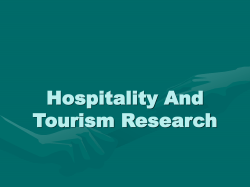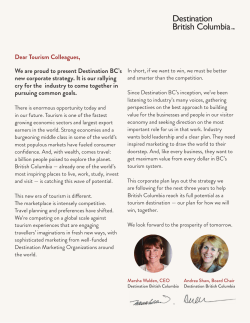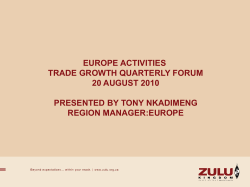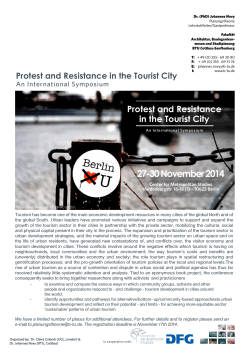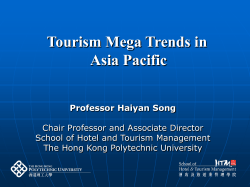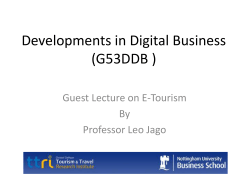
Tourism - Parliament UK
Tourism: statistics and policy Standard Note: SN/EP/6022 Last updated: 6 January 2015 Author: Chris Rhodes Section: Economic Policy and Statistics This note includes statistics on inbound and outbound visitors to and from the UK, domestic tourism in the UK, the impact of the 2012 Olympic and Paralympic Games on tourism, the contribution of tourism to the UK economy and the Government’s tourism policy. Visitor numbers in 2013: There were 32.8 million inbound visits to the UK. London was the most popular destination in the UK, attracting 51% of all visits. There were 58.5 million outbound visits from the UK. Spain was the most popular destination for UK tourists, attracting 20% of all visits. In 2012 471,000 people came to the UK for an Olympic and Paralympic related reason. There were 122.9 million domestic overnight trips made in Great Britain in 2013, 83% of which were in England. Economic impact in 2013: The tourism industry contributed £56 billion in economic output Tourism related industries employed 2.8 million people, 9% of all employment The Government published its tourism strategy in March 2011 which announced three aims: To co-fund (with the private sector) a £100m marketing campaign to encourage foreign visitors to the UK, building on publicity from international events such as the Royal Wedding and the Olympic Games. To increase the proportion of UK residents who holiday in the UK; and To increase the sector’s productivity. This information is provided to Members of Parliament in support of their parliamentary duties and is not intended to address the specific circumstances of any particular individual. It should not be relied upon as being up to date; the law or policies may have changed since it was last updated; and it should not be relied upon as legal or professional advice or as a substitute for it. A suitably qualified professional should be consulted if specific advice or information is required. This information is provided subject to our general terms and conditions which are available online or may be provided on request in hard copy. Authors are available to discuss the content of this briefing with Members and their staff, but not with the general public. Contents 1 Overseas tourism – inbound and outbound visitors 3 2 Inbound visits 3 2.1 Reasons for visit 3 2.2 Inbound visitor origin 4 2.3 Destination of inbound visits 5 3 4 5 6 7 Outbound tourism 6 3.1 Reasons for travel 6 3.2 Destination of outbound visits 6 Impact of the 2012 Olympic and Paralympic Games on tourism 7 4.1 7 Visitor numbers Domestic tourism 8 5.1 Reasons for trip 8 5.2 Destination 9 Tourism and the UK economy 9 6.1 Economic output 9 6.2 Employment 10 The Government’s tourism strategy 11 7.1 Overseas marketing 12 7.2 Increasing domestic tourism 14 7.3 VisitBritain and the future of tourism bodies 14 2 1 Overseas tourism – inbound and outbound visitors In 2013, there were 32.8 million visits to the UK by people living abroad. There were 58.5 million visits abroad by UK residents. The chart below shows the number of inbound and outbound visits to and from the UK since 1980.1 Visits to and from the UK Millions, annual data 70 60 Outbound: visits overseas by UK residents 50 40 30 Inbound: visits to the UK by overseas residents 20 10 0 Rising prosperity and falling travel costs have led to a boom in overseas tourism since the early 1980s. Between 1980 and 2013, the number of inbound visits to the UK increased by 164% from 12.4 million visits to 32.8 million visits. The number of outbound visits from the UK increased by a greater proportion – over 230% – from 17.5 million to 58.5 million over the same period. The financial crisis of 2008/09 impacted on both inbound and outbound visitor numbers. The number of outbound visitors from the UK fell particularly steeply – from a peak of 69.5 million in 2006, to 55.6 million in 2010, a fall of 13.9 million visits or 20% in 4 years. Over the two years since then, the number of outbound visits recovered slightly, increasing by 1.2 million. Inbound visitor number were also affected by the financial crisis and its aftermath but to a lesser degree than outbound visitor numbers. Inbound visitor numbers peaked in 2007 at 32.8 million visits and fell to 29.8 million in 2010 – a fall of 3.0 millions visitors or 9% in three years. 2 Inbound visits 2.1 Reasons for visit The table below shows the total number of visits to the UK by the reasons for the visit. Of the 32.8 million visits to the UK in 2013, 39% or 12.7 million were as part of a holiday; 9.3 million or 28% were made to visit friends or relatives resident in the UK; 7.9 million or 24% were for business and a further 2.8 million were made for other reasons. 1 ONS, Travel Trends, 2014 3 Inbound visits to the UK by reason for visit 2013 Millions % of total % change 2012 to 13 12.7 39% 6.4% Business 7.9 24% 7.0% Friends/relatives 9.3 28% 4.2% Misc. 2.8 9% 2.3% Total 32.8 Holiday 5.6% Source: ONS, International Passenger Survey, via Travel Trends, 2014 Notes: Based on survey responses so subject to some sampling error The total number of inbound visits to the UK in 2013 is up compared with 2012. Overall there were 1.7 million or 5.6% more visitors in 2013 compared with 2012. The biggest % increase was among people visiting the UIK for business reasons – up 7.0% or 520,000 over the year. 2.2 Inbound visitor origin The table below shows visits to the UK by country of residence. Visits to the UK by country of residence 2013 Visits (millions) Total % of total Total spend (£ millions) Average stay (nights) Whole world total 32.8 100% 21,012 7 Europe North America Other Countries 24.1 3.5 5.2 73% 11% 16% 10,902 3,081 7,029 6 8 14 1,349.6 1,408.0 2,547.7 817.5 720.4 905.2 830.4 449.3 385.8 1,193.8 5 6 8 4 5 9 7 9 3 14 Top ten countries by total number of visits to the UK in 2012 France Germany USA Irish Republic Netherlands Spain Italy Poland Belgium Australia 3.9 3.2 2.8 2.4 1.9 1.7 1.7 1.4 1.2 1.1 12% 10% 9% 7% 6% 5% 5% 4% 4% 3% Source: ONS, International Passenger Survey, via Travel Trends, 2014 Notes: Based on survey responses so subject to some sampling error Of the visitors to the UK in 2013, 73% were from Europe, 11% were from North America and 16% were from other countries. French visitors made 12%, German visitors made 10% and visitors from the USA made 9% of all visits to the UK in 2013. 4 In total, foreign visitors to the UK in 2013 spent £21 billion. Visitors from the USA, France, Germany and Australia spent £6.5 billion between them, accounting for almost a third of all spending by foreign visitors to the UK in 2013. 2.3 Destination of inbound visits The table below shows visits to the UK by destination in 2013. Destinations of overseas visitors to the UK 2013 Visits Nights (millions) (millions) Total UK Total England Total Scotland Total Wales Total Northern Ireland 32.8 28.6 2.4 0.9 0.4 Total spend (£ millions) 245.3 217.0 19.4 5.9 2.1 21,012 18,397 1,680 353 208 Top ten areas of the UK visited by overseas residents in 2013 London Lothian (Edinburgh) West Midlands Greater Manchester Kent East Sussex Hampshire Merseyside Greater Glasgow Oxfordshire 16.8 1.4 1.2 1.2 1.0 0.7 0.7 0.6 0.6 0.6 97.4 7.3 9.7 7.3 5.7 5.4 4.5 3.7 3.5 4.0 11,256.5 625.0 525.1 479.8 313.5 312.6 273.5 252.0 226.9 332.4 Source: ONS, International Passenger Survey, via Travel Trends, 2014 Notes: Based on survey responses so subject to some sampling error Includes all visitors to the UK London was the most popular destination for overseas visitors to the UK in 2013. Half of all visits by overseas residents to the UK included London. There were almost five times as many visits including London than including Scotland, Wales and Northern Ireland combined. 45% of nights spent in England by inbound tourists were spent in London. 40% of all nights spent by inbound tourists to the UK were spent in London. 61% of all money spent by inbound tourists in England was spent in London, and 54% of the money spent by inbound visitors to the UK was spent in London. 5 3 Outbound tourism 3.1 Reasons for travel The table below shows the total number of visits from the UK by the reasons for visit. Outbound visits from the UK by reason for visit 2013 Millions % % change 2011 to 12 37.6 64% 4.0% 6.8 12% -1.9% 12.5 21% 5.7% Misc. 1.6 3% -0.5% Total 58.5 - 3.5% Holiday Business Friends/relatives Source: ONS, International Passenger Survey, via Travel Trends, 2014 Notes: Based on survey responses so subject to some sampling error In total, 58.5 millions visits were made from the UK to other destinations in 2013, 3.5% up on 2012. 64% of visits abroad in 2013 were holidays. 21% or 12.5 million visits abroad were to visit friends or relatives and 12% were for business reasons. 3.2 Destination of outbound visits The table below shows outbound visits from the UK by the country of destination. Outbound visits from the UK by main destination 2013 Visits (millions) Total spend (£ millions) Average stay (nights) Whole world total 58.5 34,900 10 Europe North America Other Countries 45.9 3.4 9.2 21,539 3,935 9,426 8 15 21 Top ten countries by total number of visits from the UK in 201 Spain France USA Irish Republic Italy Germany Portugal Netherlands Greece Poland 11.7 8.9 3.0 2.9 2.8 2.4 2.1 2.0 1.8 1.7 5,976 3,642 3,580 873 1,729 928 1,122 630 1,189 686 Source: ONS, International Passenger Survey, via Travel Trends, 2013 Notes: Based on survey responses so subject to some sampling error 6 9.2 7.1 14.3 5.3 7.7 5.7 9.2 4.3 10.8 10.9 11.7 million or 20% of visits by UK residents abroad in 2013 were to Spain. 8.9 million or 15% were to France. 5% of visits aboard were to the USA, 5% were to Italy and 5% were to the Irish Republic. Of the 10 most popular destinations for overseas visits by UK residents, the longest average stays were in the USA (14 nights on average) and Greece (10 nights on average). 4 Impact of the 2012 Olympic and Paralympic Games on tourism 4.1 Visitor numbers In July to September 2012, London hosted the Olympic and Paralympic Games. The ONS published an analysis of the impact of this event on tourism to the UK.2 Overall, 471,000 people visited the UK in 2012 for an Olympic or Paralympic related reason. Roughly two thirds of these visits took place in August. The table below shows the total spend, length of average stay and top ten origin countries of visits to the UK for Olympic and Paralympic reasons. Olympics/Paralympics as main reason for visits - overseas vistors to the UK 2012 Whole world total Europe North America Other Countries Visits (000s) % of total Total spend (£ millions) 471 301 83 86 100% 64% 18% 18% 731 301 168 262 Average stay (nights) 8 5 11 16 Top ten countries by total number of visits to UK for Olympics/Paralympics USA France Germany Netherlands Belgium Italy Canada Australia Irish Republic Switzerland 66 54 46 46 19 19 17 15 14 14 14% 12% 10% 10% 4% 4% 4% 3% 3% 3% 135 99 31 34 9 16 34 38 10 15 11 2 4 4 3 7 11 19 4 6 Source: ONS, International Passenger Survey, via Travel Trends, 2012 Notes: Based on survey responses so subject to some sampling error Visitors from Europe accounted for 64% of all Olympic or Paralympic related visits. The USA accounted for 14% of visits. People visiting for Olympic or Paralympic related reasons spent £731 million and stayed for 8 nights on average (longer than the average stay in the UK – 7 nights in 2012). 2 ONS, Visits to the UK for the London 2012 Olympic Games and Paralympics, 2013 7 As well as people who visited for Olympic or Paralympic related reasons, the Olympics may also explain the increase in the proportion of overnight stays in London in 2012 compared with 2011. In 2011, 39% of all nights spent in the UK by overseas visitors were in London compared with 41% in 2012. There was also a fall of 300,000 in the number of UK residents making visits abroad in 2012 compared to 2011 which may be partly explained by an increased interest in staying in the UK due to the Olympics or Paralympics. 5 Domestic tourism ‘Domestic tourism’ in Great Britain involves residents taking trips of one or night within Great Britain. In total, 122.9 million such trips were made in 2013, down 3% on the number made in 2012.3 5.1 Reasons for trip The table below shows overnight domestic tourism in Great Britain, broken down by reason for trip. Domestic overnight tourism in GB by reason for trip 2013 Millions % Holiday 57.0 46% Business 17.8 14% Friends/relatives 44.2 36% Misc. 3.9 3% Total 122.9 - Source: Visit England, The GB Tourist, 2013, p 7 Notes: Based on survey responses so subject to some sampling error Includes all trips by GB residents within the UK of one night or more 46% of all domestic tourism trips were made as part of a holiday in 2013. 36% of trips were to visit friends of relatives and 15% of trips were made for business-related reasons. 3 Source: Visit England, The GB Tourist, 2013 8 5.2 Destination The table below shows the destination of domestic tourist trips in 2013. Destination of GB overnight domestic tourism 2013 Trips Spend Millions % £ billions % England Scotland Wales 101.8 12.1 9.9 83% 10% 8% 18.7 2.9 1.7 80% 12% 7% Great Britain 122.9 100% 23.3 100% Source: Visit England, The GB Tourist, 2013, p 7 Notes: Based on survey responses so subject to some sampling error Includes all trips by GB residents within the UK of one night or more Domestic tourists may be residents of the country they visit 83% of overnight domestic visits in Great Britain were in England, compared to 10% in Scotland and 8% in Wales. Expenditure by domestic overnight tourists in Great Britain fell by 3% in 2013 compared with 2012, partly due to a 4% fall in expenditure in England where the majority of expenditure occurs. However, overnight domestic tourists in Wales spent 7% more in 2013 compared with 2012. 6 Tourism and the UK economy The contribution of tourism to the economy is not straightforward to calculate. Several industries provide services to tourists. However, these industries might provide services to local people as well as tourists – for example, a hotel bar or a museum shop may serve local people as well as visitors. In addition, some non-tourist related industries provide services to tourists, such as parts of the retail industry. These issues are addressed by the ONS Tourism Intelligence Unit which disentangles the total contribution of tourism related industries from the direct contribution made by tourism. The annual Tourism Satellite Account (TSA) publishes estimates of economic output related to tourism on this basis. 6.1 Economic output In 2013, the economic output of the tourism industry in the UK was £56 billion.4 Over the past five years, output from the tourism industry has grown considerably in the UK, from £49 billion in 2008 to the current level, a 14% increase. 4 ONS, Estimates of the economic importance of tourism 2008-2013, December 2014. This publication uses Gross Value Added (GVA) to estimate economic output. GVA is the value of goods and services produced by part of the economy such as an industry or region, minus any costs incurred in production. 9 This growth mainly occurred in 2011 (9% growth compared to 2010) and 2012 (5% growth compared to 2011). This suggests a possible ‘Olympic effect’. The tourism industry barely grew at all in 2013 compared to 2012. The parts of the tourism industry that have seen the biggest growth have been the food and drink serving industry, which contributed 1.3% growth out of a total of 4.9% growth in 2012 compared with 2011. Other sub-sectors which saw strong growth were the accommodation industry and the sports and recreational activities sector. Tourism has grown more quickly than other industries since 2008. The following chart shows the change in the economic output of various industries, with tourism highlighted. 5 % growth in economic output, 2008-2013, selected industries Over this period, tourism grew by 14%, more than retail (12%) but significantly less than the real estate industry which grew by 30%. 6.2 Employment In 2013, there were 2.8 million people employed in tourism industries in the UK. This was 9% of UK employment.6 Employment in tourism has grown by 5.4% since 2009, compared with 2.8% growth in total employment. 5 Chart from ONS, Tourism grows at a faster rate than other industries Estimates of the economic importance of tourism 2008-2013, 6 ONS, Employment in Tourism Industries, 2009-2013, September 2014 10 Employment in tourism related industries UK, 2013 000s Accommodation for visitors Travel agencies and transportation Cultural, sports and recreational Food and beverage serving 360 500 709 1,238 Tourism related total 2,805 % of all employment 9% Source: ONS, Annual Population Survey Via, ONS, Employment in tourism industries 2009-2013, p5 The biggest tourism related industry is the food and beverage serving sector, employing 1.2 million people in 2013, 44% of tourism related jobs. The next biggest sector is the cultural, sports and recreational sector, employing 709,000 people 25% of tourism employment. Tourism employment is larger in the UK compared to many other countries, as the following chart shows. 7 Of the countries featured below, the UK has the third largest tourism industry as a proportion of employment – 9%. This compares to Spain with 14% and Brazil with 11%. Countries with smaller tourism sectors include Germany with 6% and France with 5%. Employment in tourism as a % of total employment 2012 16% 14% 12% 10% 8% 6% 4% 2% 0% 7 The Government’s tourism strategy Tourism is a wholly devolved policy area, which in England comes under the responsibility of the Department for Culture Media and Sport (DCMS). The Development of Tourism Act 1969 established the Wales Tourist Board, the Scottish Tourist Board (now VisitScotland) and the English Tourist Board and British Tourist Authority (now VisitBritain). 7 ONS, Employment in Tourism Industries, 2009-2013, September 2014, p 2 11 The Government Tourism Policy was published on 4 March 2011 by the Department for Culture, Media and Sport. This announced that the Government aimed to: Fund the most ambitious marketing campaign ever to attract visitors to the UK in the years following 2012. The £100m campaign, co-funded by the government and the private sector, aims to attract 4 million extra visitors to Britain over the next 4 years. That equates to £2bn more spend in our economy, and 50,000 new jobs. Increase the proportion of UK residents who holiday in the UK to match those who holiday abroad each year. For longer stays (4 nights or more) this would mean 29% of travellers holidaying in Britain rather than just 20% today… Improve the sector’s productivity to become one of the top 5 most efficient and competitive visitor economies in the world.8 The Plan for Growth, published alongside the Budget in March 2011, considered tourism alongside other industries and set out a series of actions to encourage growth in the sector. These included plans to increase the number of apprenticeships and other courses teaching hospitality and to make it easier for tourists to visit the UK by increasing the number of visa biometric ID visa centres around the world and to move to online visa processes. The Government intends to the sector’s reliance on taxpayer funding and increase the amount of money available for “collective destination marketing”, and create a “sustainable new model of destination marketing and management” the back of 2012 Olympic games, allowing tourism to come of age as an independent and self-confident sector of Britain’s economy.9 7.1 Overseas marketing There are two official campaigns involved in marketing Britain overseas: the ‘GREAT Britain: You’re invited’ campaign and the GREAT image campaign. The ‘GREAT Britain: You’re invited’ campaign was announced in January 2011.10 This campaign seeks to attract visitors who have never been to Britain before; to encourage prior visitors to return; and to provide opportunities and incentives to visit Britain. It was announced in the Autumn Statement 2013 that funding for this campaign would be increased by 50% to a total of £45 million in 2014/15 and 2015/16. This campaign is match funded, meaning that the Government will provide at total of around £23 million in each of next two financial years, with the remainder of the funding coming from the private sector.11 The GREAT image campaign is campaign that is funded separately from the GREAT Britain: You’re invited campaign. The GREAT image campaign was announced in February 2012 by the Prime Minister David Cameron. It is employed by all of the agencies across Government that seek to market Britain overseas, including UKTI, the British Council and the Foreign and Commonwealth Office. The first phase of the tourism campaign targeted nine countries, with adverts appearing in: Beijing, Berlin, Los Angeles, Melbourne, Mumbai, New Delhi, New York, Paris, Rio de Janeiro, Sao Paulo, Shanghai, Sydney, Tokyo, and Toronto. DCMS has stated that around 70 per cent of the population in each of the target cities will saw the 8 Department for Culture, Media and Sport, Government Tourism Strategy, March 2011, p7 Government Tourism Plan, 4 March 2011, p 8 10 VisitBritain, GREAT Britain: You’re invited, website 11 HM Treasury, Autumn Statement 2013, 5 December 2013, p 100 9 12 advertising on billboards, TV, or in the cinema.12 VisitBritain was allocated £17 million for the GREAT image campaign in 2014/15.13 The combined objectives of these campaigns are to achieve the following by March 2015: 4.6 million visitors £2.3 billion visitor spend 57,000 job opportunities £460 million in tax revenues Progress against these targets is measured on the VisitBritain website and in the VisitBritain annual reports, the most recent of which was published in October 2014: VisitBritain: Key performance indicators 2013/14. The Tourism Alliance has stated that their concern that with the campaigns: …the Government’s committed expenditure (£12.5m per annum for four years from VisitBritain’s greatly reduced grant) is insufficient to achieve the targeted £2bn Olympic Tourism legacy and 50,000 new jobs. By comparison, New Zealand spends more than the combined marketing budgets of VisitBritain, VisitScotland and VisitWales on its “100% Pure New Zealand” campaign and, in 2011, Tourism Ireland will spend more on marketing in the UK than VisitBritain has to promote the UK in all international markets.14 Further information on VisitBritain’s strategy for attracting overseas tourists to Britain can be found in Delivering a golden legacy published in April 2013. This sets an ambition to attract 40 million visitors and earn £31.5 billion (in real terms) from inbound tourism by 2020. This would support 200,000 additional jobs across the UK per annum. The key elements of the strategy are:15 Improve Britain’s image abroad, by building on the work of the GREAT campaigns. Work with the travel trade in key markets to increase awareness of the UK as a holiday destination via brochures and package products, and also as a location for business events and conferences. Package and promote more areas of the UK to the trade. Improve the range of product on offer. Food and drink and mid-range accommodation are areas of perceived weakness in Britain according to potential tourists surveyed by VisitBritain Make Britain easier to visit by encouraging the development of more air routes to Britain and by working with the Home Office and the Foreign and Commonwealth Office to challenge misconceptions about the visa regime and improve the visa application process. 12 DCMS, Britain's biggest ever international tourism campaign goes global, 9 February 2012 VisitBritain, press release: On track to outstrip GREAT campaign targets, 8 October 2014 14 Tourism Alliance, Tourism for Growth, p4 15 VisitBritain, Delivering a golden legacy: a growth strategy for inbound tourism to Britain, 2012-2020, April 24 2013, p35 13 13 7.2 Increasing domestic tourism One of the Government’s aims set out in the paper is to: Increase the proportion of UK residents who holiday in the UK to match those who holiday abroad each year. For longer stays (4 nights or more) this would mean 29% of travellers holidaying in Britain rather than just 20% today (creating 4.5m extra domestic trips each year, £1.3bn more spend and 26,000 new jobs). And if we can replicate this scale of improvement for shorter stays as well, we will create a further £750m of spend and 11,000 new jobs.16 The policy document continues: Britain usually runs a large tourism trade deficit because we are far more likely to travel abroad for our holidays than most other countries. Currently, less than 40% of our total holiday spending goes on domestic tourism – roughly a 2:1 trade deficit. And these recent figures are probably rather optimistic; before the effects of a low pound, recession and a volcanic ash cloud had taken their toll, the average for 2006-08 was just 31%. We’re worse than our neighbours too: just 21% of us holiday at home, compared to 28% on average for other European countries. But 29% of us holiday abroad compared to just 16% in the rest of Europe.17 In 2010, UK tourists spent £30.9 billion on trips overseas whereas overseas residents spent £16.7 billion on trips to the UK; a balance of payments of £14.2 billion.18 The percentage of UK tourism expenditure spent on domestic tourism has risen from 36% in 2007 to 40% in 2010. To boost domestic tourism, the strategy paper suggested moving the May Day bank holiday to October to extend the tourism season. On 12 May 2011 the Government launched a “preconsultation” these proposals.19 In April 2012 the Government stated that a decision about the outcome of the pre-consultation would be made “in due course”.20 The strategy paper also raises the possibility of encouraging domestic package holidays. 7.3 VisitBritain and the future of tourism bodies In October 2010 the Government announced that the resource grant-in-aid budget for VisitBritain and VisitEngland would be cut by 34% in real terms by 2014-15. The total grant in aid budget for both organisations (including capital) will be £128.6m over four years. VisitBritain’s total grant in aid over this period accounts for £95.7m, and VisitEngland accounts for £35.9m. The Secretary of State’s letter to the Chair of VisitBritain stated that: Funding for the following top priority programmes to be protected as far as possible: - VisitBritain’s core international marketing and PR activity in the top and emerging international markets. This will be provided in the expectation that it is matched by the private sector; 16 DCMS, Government Tourism Policy, March 2011, p7 Ibid, p15. The policy document uses information published by Eurostat on participation in tourism - Eurostat, Tourism statistics in the European Union 2008 data, 2010, p11 18 ONS, Quarterly Overseas Travel and Tourism, Q4 2010 and 19 DCMS, Pre-Consultation on moving the May Day Bank Holiday, May 2011 20 HC Deb 26 April 2012 c875W 17 14 - VisitEngland’s investment in and support for destination management organisations and the local businesses, local authorities and enterprise partnerships involved in tourism. your administration budgets to be cut by around 50% in real terms which will lead to: - downsizing and refocusing VisitBritain’s overseas presence; - ceasing VisitBritain’s advocacy function, though continuing to inform DCMS Ministers’ own advocacy within Whitehall on behalf of the sector; - rationalising VisitEngland’s involvement in and the delivery of the quality schemes and the digital platforms.21 For more information (including a breakdown by year and by resource and capital budgets for each organisation) see the Spending Review letter sent from DCMS to VisitBritain on 20 October 2010. The 2011 tourism strategy announced changes to the role of VisitBritain, and changes to local tourism bodies. VisitBritain was to be “refocused” on “researching, creating and delivering a series of marketing campaigns to attract ever-greater numbers of inbound travellers to the UK”.22 Other existing responsibilities would be transferred to VisitEngland or abolished altogether. The tourism strategy also pledged to “modernise and update local tourism bodies to become focused and efficient Destination Management Organisations (DMOs)”.23 DMOs will be bodies involving local tourism support bodies, local attractions and interests, local business networks, the new Local Enterprise Partnerships and local councils. DMOs will define their own boundaries and areas of responsibility. The strategy states that once the boundaries, role and governance of the DMOs has been established, they would need to become less reliant on public funds and instead be funded through partnerships with the private sector in the same way as the VisitBritain national marketing campaign described above. Government funding for tourism has previously been delivered through a variety of channels, including local authorities, Regional Development Agencies and VisitBritain, the central public body tasked with promoting tourism. With all of these organisations facing cuts to real term spending (or abolition in the case of RDAs) over the course of the Spending Review period, there are concerns that tourism will not benefit from the same levels of support it has enjoyed in the past. Some functions of the RDAs will be taken on by new Local Enterprise Partnerships (LEPs), although these are not directly replacing the regional bodies.24 The Tourism Alliance has expressed concerns regarding the impact of transition from RDAs to LEPs on tourism promotion:25 If the new LEPs are not established in a coherent and coordinated manner, providing national coverage for tourism businesses, the future cohesion within the industry, and the 21 Letter for the Secretary of State for Culture Media and Sport to the Chair of VisitBritain, 2010 Spending Review, 20 October 2010 22 Department for Culture, Media and Sport, Government Tourism Strategy, March 2011, p21 23 Ibid, p21 24 For background on LEPs see Standard Note SN/EP/5651, Local Enterprise Partnerships 25 Tourism Alliance Submission to BIS Inquiry: The New Local Enterprise Partnerships, 13 August 2010 15 implementation of national programmes for tourism development, including the new National Tourism Strategy for England, could be seriously compromised. The Alliance argued that there is a danger that tourism development will be lost in the transition between RDAs and LEPs, claiming “it seems likely that some essential core tourism development tasks previously carried out via the RDAs will be terminated before the new arrangements are in place”.26 They note that it remains unclear where responsibility for implementing the National Tourism Strategy will lie under the new arrangements and express further concern that knowledge and contacts built up by RDAs could be lost. 27 On 31 October 2011 it was announced that VisitEngland had been successful in bidding for funding from the Regional Growth Fund. The funding is to be allocated to a number of destination partners in England. VisitEngland has stated that their partners include Marketing Manchester, Marketing Birmingham, Bath Tourism Plus, Visit Peak District and Derbyshire, Cumbria Tourism and Visit York. In addition to targeted activity in these areas there will be a series of thematic campaigns focusing on countryside, heritage, coastal and business tourism.28 26 27 28 Ibid For background on LEPs see Standard Note SN/EP/5651, Local Enterprise Partnerships Visit England, VisitEngland’s Regional Growth Fund Bid is Successful 16
© Copyright 2025
